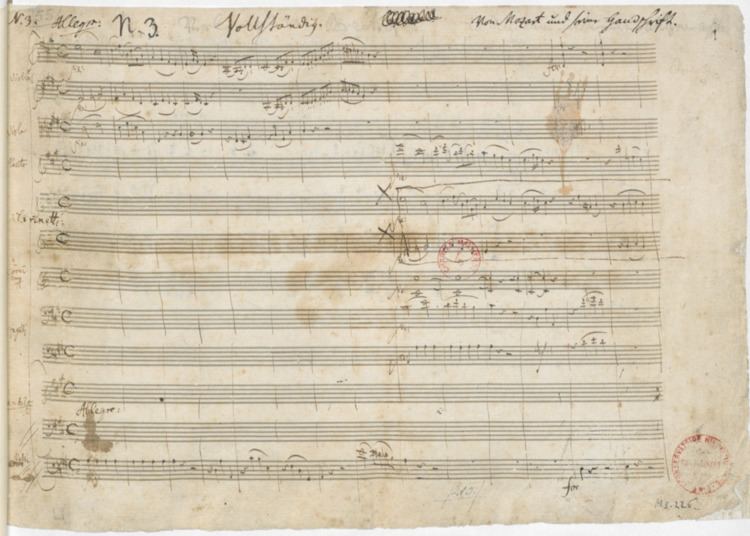Composed 1786 (1786) | Catalogue K. 488 Published 1800 (1800) | |
 | ||
The Piano Concerto No. 23 in A major (K. 488) is a composition for piano and orchestra written by Wolfgang Amadeus Mozart. It was finished, according to Mozart's own catalogue, on March 2, 1786, around the time of the premiere of his opera, Le nozze di Figaro. It was one of three subscription concerts given that spring and was probably played by Mozart himself at one of these. The concerto is scored for piano solo and an orchestra consisting of one flute, two clarinets, two bassoons, two horns and strings. In Mozart's later works the wind instruments are equal to the stringed instruments, and this is also the case in this concerto.
Structure
The concerto has three movements and lasts about 26 minutes:
- Allegro in A major and common time.
- Adagio in F-sharp minor and 6/8 time or 3/4 time (in later editions, the tempo is listed as Andante).
- Allegro assai in A and alla breve (in later editions, the tempo is listed as Presto). In Rondo form.
The first movement is in A major and is in sonata form. The piece begins with a double exposition, the first played by the orchestra, and the second when the piano joins in. The first exposition is static from a tonal point of view and is quite concise, the third theme is not yet revealed. The second exposition includes the soloist and is modulatory. It also includes the previously unheard third theme. The second exposition is ornamented as opposed to the first exposition which is not. The second theme has harmonic tension. This is expressed by dissonances that are played on the beat, and then solved by an interval of a descending second. This is also expressed in the use of chromatics in the melody and bass lines which is a source of harmonic tension, as the listeners anticipate the arrival of the tonic.
The second, slow movement, in ternary form, is somewhat operatic in tone. The piano begins alone with a theme characterized by unusually wide leaps. This is the only movement by Mozart in F sharp minor. The dynamics are soft throughout most of the piece. The middle of the movement contains a brighter section in A major announced by flute and clarinet that Mozart would later use to introduce the trio "Ah! taci ingiusto core!" in his opera Don Giovanni.
The third movement is a rondo. It is shaded by moves into other keys as is the opening movement (to C major from E minor and back during the secondary theme in this case, for instance) and with a central section whose opening in F sharp minor is interrupted by a clarinet tune in D major, an intrusion that, according to Girdlestone, reminds one that instrumental music at the time was informed by opera buffa and its sudden changes of point of view as well as of scene.
